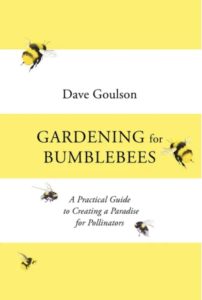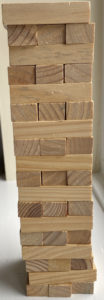Gardening for Bumbeless- A Practical Guide to Creating a Paradise for Pollinators By Dave Goulson
As with his other popular books, Professor Dave Goulson has this canny knack of using his vast academic experience, mixing it with practical experiences and then translating numerous scientific research papers into everyday language. He weaves all these strands together with wit and humour so that others can easily read and readily identify with the message he is sending to the reader, without preaching. His light-hearted message reminds me of Mohammed Ali with his “Float like a butterfly, sting like a bee” approach! This is a craft that he performs admirably. No wonder he has best sellers in his authored book list.
It is an expanded version of his Gardening for Bumblebees, a great little booklet published by the Bumblebee Conservation Trust. a trust which Dave Goulson himself formed. The new larger book I like better. Because it is targeting specific areas within a larger topic area. i.e. wildlife gardening (a huge topic area). It focuses right into the beating heart of bumblebees and he includes other pollinators, throwing the light on these often forgotten heroes visiting our gardens. I say visiting but if the truth be known they are also really helping to make and sustain our wildlife gardens.

Gardening for Bumblebees by Dave Goulson
The Mother Earth ‘Jenga’ Syndrome
This is the message I get from Dave Goulson’s books. I call it the Mother Earth ‘Jenga’ Syndrome. (Other wooden towers are available!). You have a tower built of wooden blocks inside a loading tray or cardboard box. The blocks are carefully emptied onto the floor or hard surface and adjusted if needed to make a tower. The wooden tower represents Mother Earth and each block represents a species. You remove a block (becomes extinct) and nothing happens, another is removed nothing happens. More and more blocks are removed. Then one block is removed and the tower collapses. In the game, the blocks are replaced onto the top of the tower, but you get the gist.

Wooden Tower of Blocks
Pollinators are part of the ‘tower’ and are key blocks within it holding up the other blocks. Remove them and the tower will collapse. Industrial farming, climate change, overuse of chemicals, deforestation, destroying other natural habitats represents us removing a block. We won’t be able to build another tower without any blocks.
Other insect pollinators
I do like the emphasis on some insect pollinators that visit our gardens. As there being probably far too many if not daunting to learn about at least he has concentrated his work on those likely to visit our garden, making them easier to identify. Pollinators offer another angle to wildlife gardening, instead of the usual hedgehogs, birds, trees, etc. of which there is a great deal already on offer. Pollinators and other insects are the cornerstone or foundations of wildlife gardening, as they are, besides pollinating our wildflowers and crops, a food resource for the birds, mammals and invertebrates.
Likewise, he has steered clear of most of the numerous species of solitary wild bees and concentrated on garden visitors. This is great for gardeners as it offers the opportunity to keep an eye out for them. There are simply too many to study and an excellent book on the subject is already available by Steven Falk “Field Guide to the Bees of Great Britain and Ireland” which is supported by his first-class Flickr website.
I love tidbits of information and this book is full of them. For example, the bumblebee hoverfly, Volicella bombylans. The heroic female lays her eggs in bumblebee or wasp nests and, if she is killed by the hosts in trying to lay her eggs, she automatically lays all of her remaining eggs! Her larvae scavenge in the nest generally don’t do any harm, so far as anyone knows. They remove the waste and detritus in the nest which may be of benefit to their hosts. He states, as far as anyone knows, which means it has not been thoroughly observed or researched. This whets my appetite and I may try and find this out! Although Prof. Goulson states that he and others took almost 5 years to unravel that bees accidentally leave behind a smelly footprint after visiting a flower that other bees can detect and they don’t bother landing to save them wasting time. On second thoughts then I may give this a bumblebee hoverfly larval effects inside a bee nest a miss!
Then there is a murderous fly, which can hover like a hummingbird and I often watch as they feed upon my primroses, flitting from flower to flower with their long proboscis always extended to save time. Yes, it’s the furry bumblebee mimic Bombylius major or Bee fly. Like a helicopter, hovering close to bee nests, she flicks her eggs into the entrance tunnel. Like troops disembarking from a helicopter they enter the tunnel and then go about their life’s mission which is to find host larvae, eat them then eat the hosts’ food reserves. Personally, I find stuff like this fascinating.
The book is not overpowered with glossy colourful and large photographs. I like this idea. There are one or two paragraphs about subject species matter along with a small photograph. Even the small mint moth gets a paragraph and a small photograph.
Flower list
Like people put out many different types of bird feeders, so as you can imagine, Dave Goulson’s list of flowers is a mix of personal observations and research. It is also a mix of native and non-native flowers. I use such a mixture believing that pollinators are not bothered whether the nectar or pollen they collect is from a native or non-native. To them, food is food, right! Although English Bluebells grown from seed is mentioned, according to the National Trust they can take 5-7 years from seed to flower, so you will have to be very patient and remember to avoid the Spanish bluebell. I use bluebells in the green, a much quicker job, as is splitting clumps up when they have flowered.
So if you are just starting out with a wildlife garden or just want to help bees and other wildlife pollinators, full of interesting facts, tidbits, a nice blend of science and experience, then you would be well advised to read this book.
Yes, Dave mentions me and my products in this book. Which was very nice of him as I did n’t have to pay him! He wrote in his other book ‘The Garden Jungle’ “I do not get a cut of his sales and have no ambition to get a job as George’s marketing manager!” Now that is a pity!!
It is available to purchase from NHBS who currently have a special offer on it.
For this who want more information about wildlife gardening I recommend these books:
RHS Companion Guide to Wildlife Gardening By Professor Chris Baines (The Father of wildlife gardening)
Wildlife Gardening For Everyone and Everything By Kate Bradbury (her enthusiasm will rub off onto you!)

Already a big fan of Dave Coulson, and have a couple of his books. Great that he is putting in a word for you George. We need all the Dave Coulson and George Pilkington’s we can get !
That’s very kind of you to say so Syra. Thank you. Cheers George NN